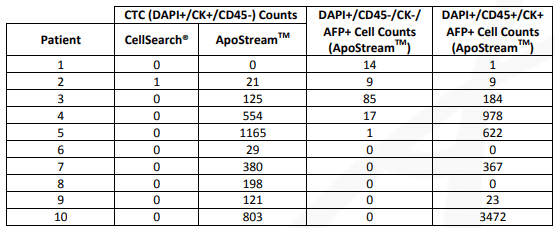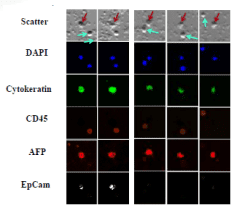CASE STUDY
Optimization of CTC Recovery Methods and Biomarker Analysis in Hepatocellular Carcinoma Patients
Clinical Application: pharmacodynamic analysis of compound therapy in hepatocellular carcinoma (HCC) patients
Key Words: CTCs, protein expression, pharmacodynamics, head-to-head comparison, ApoStreamTM, HCC
Background: Hepatocellular carcinoma (HCC) is a rare cancer type in the United States; a large number of HCC cases are from distant metastases arising from other cancers, indicating that circulating tumor cells play a role in the development of this disease. This study examines the pharmacodynamic effects of a combination therapy regimen – an HDAC inhibitor coupled with a Raf pathway inhibitor – in isolated CTCs by examining biomarkers that govern a common apoptotic pathway. The biomarkers of interest are direct participants in the pathway under examination and an inhibitory protein that can stop the signaling cascade.
Methods: Blood was drawn from up to ten HCC patients and CTCs enriched using both the CellSearch® CTC kit and the ApoStream™ device. CTCs were enumerated through Laser Scanning Cytometry (LSC) as cells exhibiting a DAPI+/CK+/CD45- phenotype, counts from the two platforms compared, and the ApoStream™ was selected for use in the remainder of the trial. In the second phase, blood from up to an additional ten HCC patients was drawn and enriched using the ApoStream™. Enriched cells were stained for the CTC phenotypic markers and the biomarkers of interest for the trial as discussed above.
Results:

Figure 1. CTC enumeration results from ten pilot patients. Alpha fetoprotein (AFP) was used as both a screening method and a downstream biomarker for further cellular classification. Results illustrate ApoStreamTM serves as a capable system for the isolation of circulating tumor cells, recovering many more cells than the CellSearch® CTC kit. ApoStreamTM also isolates potential CTCs of other phenotypes (CK-/CD45-/AFP+ and CK+/CD45+/AFP+).

Impact:
ApoCell has illustrated the capabilities of the ApoStreamTM as a means of isolating circulating tumor cells from patients with HCC and incorporated its use into an ongoing clinical
study.
References: Poklepovic, A. et al. “ApoStreamTm, an Antibody Independent Platform, Captures Circulating Tumor Cells in Patients with Hepatocellular Carcinoma.” AACR, 2012.